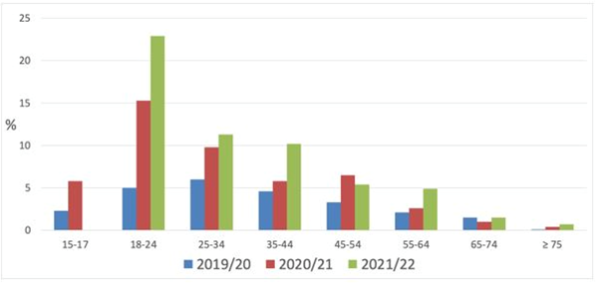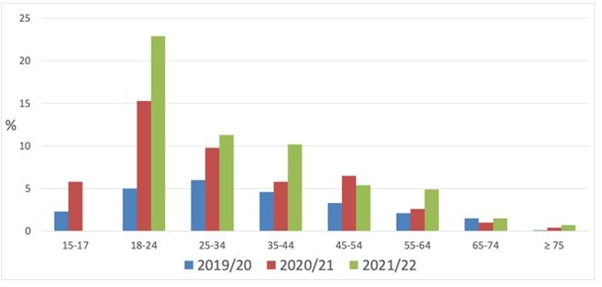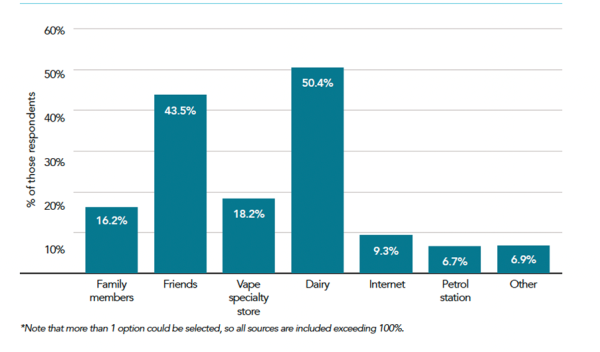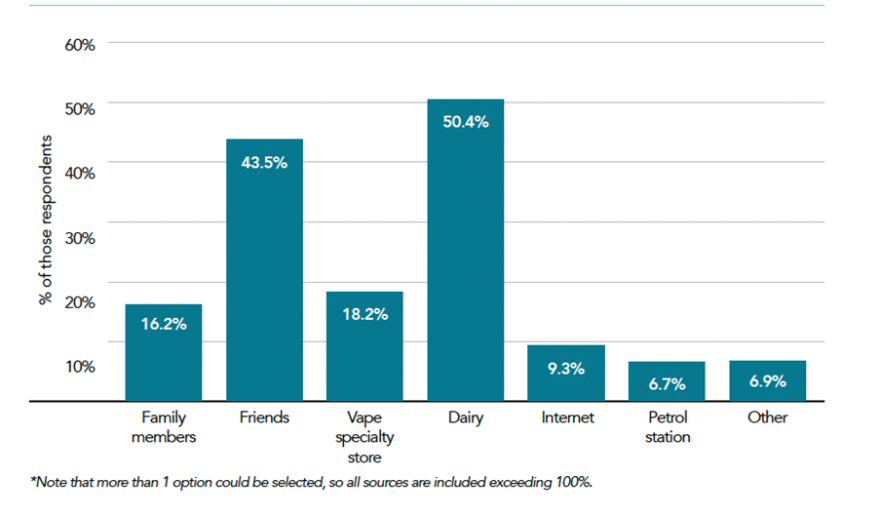Summary
There is growing concern about the increasing prevalence of vaping among young people in Aotearoa New Zealand. In this article, we collate the latest data from available sources about the prevalence of vaping and related beliefs and patterns of behaviour among adolescents and young adults. We highlight the limited information available and the need for improved monitoring information for this key age group.
There has been growing concern and related commentary about increasing vaping among young people in Aotearoa New Zealand (NZ). This briefing collates the latest data on the prevalence, trends and patterns of vaping and smoking among adolescents and young adults from key population-based surveys.
Sources of information
The main information sources used in this briefing are summarised in supplementary information . Figures 1,2 and 5 are reproduced from a recent report by ASH New Zealand,1 figures 3, 6 and 7 are from a recent scholarly blog2 and figure 8 is from a report published by the Asthma and Respiratory Foundation (ARF).3 A key finding of this review is that information available on vaping-related attitudes, beliefs and behaviours among adolescents and young adults in NZ is very limited.
Vaping prevalence and trends in adolescents and school students
The ASH Year 10 Snapshot Survey (‘Snapshot survey’) provides national level information on vaping among 14-15 year old school students. Figures 1 and 2 show recent trends in daily and regular (at least monthly) smoking (1999-2022) and vaping (2015-2022).1 The survey did not occur in 2020 due to COVID-19.
Figure 1: Year 10 (14-15 years) daily smoking (1999-2022) and daily vaping prevalence (2015-2022)
Figure 2: Year 10 (14-15 years) regular (at least monthly) smoking (1999-2022) and vaping prevalence (2015-2022)
Daily and regular smoking prevalence declined dramatically from 1999 to 2016 (daily smoking from 16% to 3% and regular smoking from 28% to around 5%), and then approximately plateaued until 2019, since when it has decreased again. Daily smoking prevalence was 1.1% and regular smoking prevalence 3% in 2022.
Data on vaping is available only since 2015, when prevalence was relatively low, after which regular and daily vaping increased steadily up to 2019, and very rapidly between 2019 and 2021 (figures 1 and 2). Prevalence remained broadly similar in 2022 when 10% of year 10 students vaped daily and 18% were regular vapers.
Trends in smoking and vaping prevalence are available for 15-17 year olds from the New Zealand Health Survey (NZHS) from 2011/12 to 2021/22. The 2021/22 survey was greatly affected by COVID-19 and the sample is insufficient to produce reliable estimates of prevalence in this age group. Figure 3 shows trends in daily and current (at least monthly) smoking and vaping prevalence for 15-17 year olds are similar to those shown in figures 1 and 2 for 14-15 years students.2
Figure 3: Current (at least monthly) and daily smoking and e-cigarette use among 15-17 year olds, 2011/12 to 2020/21
Further evidence on prevalence of smoking and vaping among 13-18 year olds comes from the Youth 19 survey4 5 and the ARFNZ/SPANZ Vaping in NZ Youth Survey (ARFNZ).3
In the Youth 19 survey (2019) current (at least monthly) and at least weekly vaping prevalence was 9.8% and 5.8% respectively, while smoking prevalence was much lower: current smoking prevalence was 3.8% and weekly smoking prevalence 2.8%. In the 2021 ARFNZ, 14.6% of participants reported smoking and 26.6% reported vaping in the last week.
Vaping prevalence and trends in adolescents and school students – by ethnicity and socio-economic status (SES)
The Snapshot survey reveals substantial inequities in smoking and vaping prevalence by ethnicity (figures 4 and 5).1 In the 2022 survey daily (21.7%) and regular (33.8%) vaping were most prevalent among Māori year 10 students, with prevalence highest among Māori girls: daily vaping 25% and regular vaping 39%.
Figure 4: Regular (at least monthly) and daily smoking and vaping prevalence by ethnicity among 14-15 year olds in 2022
Figure 5 shows recent trends in daily vaping prevalence from the Year 10 Snapshot survey by ethnicity. It shows a dramatic increase in daily vaping among Māori girls from around 5% in 2019 to 25% in 2022.
Figure 5: Daily vaping prevalence by ethnicity & gender (2015-2022) in ASH Year 10 Snapshot Survey
Current data on vaping prevalence by deprivation is sparse and inconsistent. Vaping by school decile (a measure of SES at school level) has not been published for the most recent Snapshot surveys. In the 2019 Youth 19 Survey, weekly vaping prevalence was higher in the least deprived compared to the most deprived school student groups: for example prevalence was 9.3% among participants at decile 8-10 (least disadvantaged) schools vs 3.0% at decile 1-3 (most disadvantaged) schools and 7.0% among participants living in NZDep 1-2 areas (least disadvantaged) vs 3.2% in, NZDep 9-10 (most disadvantaged) areas.5 In contrast, two years later in the 2021 ARFNZ vaping prevalence was higher in low decile schools,3 which could reflect the replacement of relatively expensive ‘pod’ devices with cheaper disposables making vapes more affordable for youth living in more disadvantaged areas.
Vaping prevalence and trends in young adults
NZHS data (figure 6) shows broadly similar recent trends for smoking and vaping among young adults as for 15-17 year olds.3 Smoking prevalence declined steadily to 2018/19, with the decline accelerating between 2018/19 and 2020/21. Vaping prevalence increased from 2015/16 to 2019/20, after which the increase accelerated rapidly, reaching 22.9% daily and 27.8% regular vaping prevalence by 2021/22.
Figure 6: Trends in current and daily smoking and e-cigarette use among 18-24 year olds, 2011/12 to 2021/22
The NZHS Data Explorer does not allow examination of smoking and vaping prevalence among age groups stratified by ethnicity or SES.
Vaping prevalence in the adult population is far higher among young adults than among older age groups (figure 7). The pattern is similar for regular vaping prevalence (data not shown).
Figure 7: Daily e-cigarette use by age group (NZHS 2019/20 to 2021/22)
Interaction between vaping and smoking
Vaping prevalence in the Snapshot survey and NZHS began to exceed smoking prevalence among adolescents and young adults around 2018-2020, with some variation by age group and prevalence (daily vs regular) measures. By 2021/22, vaping prevalence was substantially higher than smoking prevalence for all age groups, measures and surveys. Daily and regular vaping rates among Year 10 students in 2022 are comparable to daily and regular smoking prevalence from the early 2000s (figures 1 and 2).1
Vaping prevalence is reported in relation to smoking status (for daily smokers and never smokers) in the Snapshot survey reports but is not available in the NZHS data explorer. In 2022, most daily smokers aged 14-15 years also vaped (95% were regular vapers and 86% were daily vapers).1 The proportion of never smokers who vaped was much lower, but has been steadily increasing – 4% were daily vapers and 10% regular vapers in 2022. However, because most 14-15 year olds do not smoke, it is also important to consider actual numbers of vapers in relation to smoking status. Our analysis (see supplementary information) suggests that among 14-15 year olds less than 10% of daily vapers and around 6% of regular vapers are daily smokers, whilst over one third of daily vapers and almost half of regular vapers are never smokers.
Device type and use of flavours
E-cigarettes started to become widely available in Aotearoa around 2010. Vaping devices and products have since evolved rapidly and continuously. Until recently ‘mod’ or ‘tank’ devices with refillable liquid tanks, rechargeable batteries, and the ability to vary temperature and voltage and customise the device components were the most commonly used vaping device, for example used by 86% of vapers in the 2018 ITC NZ/EASE survey of people who smoke or had recent quit.6
A new type of device using replaceable or refillable ‘pods’ (eg, ‘Juul’) often with high concentration nicotine salt e-liquids emerged in 2016 and became available in NZ around 2018. These devices were easy to use, discreet, ‘high tech’ in appearance and delivered nicotine very effectively. Evidence from USA suggested that their introduction combined with multiple attractive flavour options and youth-focused marketing resulted in a rapid increase in their use and in vaping prevalence among young people.7-9
More recently, cheap and highly appealing, high-nicotine content disposable vapes have become available. Use of these products among youth has increased rapidly in some countries, like the UK, where the proportion of current vapers using disposables increased from 10% in February 2021 to 67% in August 2022,10 with similar findings in the Smoking Toolkit Survey. Disposable vapes were introduced in NZ in 2020 and multiple brands and flavours are now available for as little as $6 per device.
There is very limited quantitative data available on type of vaping products used by young people in Aotearoa. The Snapshot survey asks about usual type of device used. The most recently available data is from 2021 when 63.5% of daily vapers (47% of all vapers) used refillable tank devices, 20.6% (20.4% all vapers) used reusable cartridge (‘pod’) vapes and 9.1% (12.2% all vapers) used disposable vapes.11 The vaping market has changed greatly since 2021 and anecdotal reports suggest disposables are now the most frequently used devices by young people in Aotearoa. In the future, tracking vaping returns data may provide more robust estimates of device popularity in NZ.
Studies from many countries have found that young people mostly vape with flavoured devices/e-liquids, with fruit and sweet flavours particularly popular, and that they prefer using flavoured vapes.12 For example, in the 2022 UK ASH survey of 11-18 year olds, the most common reason (20.8%) given for vaping among current smokers was ‘I like the flavours’.13
There are no data on use of vape flavours among youth and young people in Aotearoa. In the 2021 Snapshot survey, about 13% of daily vapers stated ‘I like the flavours’ as a reason for vaping.11 The Hā Collective survey found the factors most commonly cited as ‘very important’ for choosing a vape were flavour (44%) and nicotine content (43%).14 Other factors such as cost, brand, ease of use and look of the device were less commonly cited. Nicotine content was particularly important for daily vapers (61% cited this as very important).
Use of nicotine vapes and measures of addiction or dependence to vaping
There are diverse and often contested views about what constitutes addiction (or ‘dependence’) in relation to vaping. However, some facets of this topic are established. First, the main constituent of vapes responsible for addiction is nicotine. Addiction will therefore be confined to users of nicotine-containing vapes, and will be more likely among users of high strength vaping products. Addiction will also be much more frequent among daily users, particularly youth who report using devices multiple times per day.
Most young people in Aotearoa who vape use nicotine-containing devices and e-liquids. In the 2021 Snapshot survey, 68.5% of all vapers and 89% of daily vapers usually vaped with nicotine.11 Of the ARFNZ sample, only 2.8% of vapers reported using zero nicotine vapes. The majority (79.9%) used high nicotine (24-50mg) vapes, including 95% who reported vaping multiple times per day. Of all vapers in the ARFNZ, 74.8% were vaping daily with 59.3% reporting vaping multiple times per day.3
Measures of addiction or dependence for vaping are not agreed, though scales have been proposed and applied, often finding high levels of dependence, particularly among ‘pod’ device users.15-17 Self-perceived addiction has also been measured. For example, in the ITC youth surveys, self-perceived addition among current vapers aged 15-19 years in USA, Canada and the UK increased from 31-36% in 2017 to 56-64% in 2022.10 Similarly, in the ARFNZ, 63.3% of current vapers reported they felt addicted to vaping, including 54% of daily vapers and 86.3% of students who vaped multiple times per day. There are no studies from Aotearoa assessing levels of addiction using more objective scales and measures.
Source of vaping products
In the 2021 Snapshot survey, social supply such as friends giving them vapes (43%) or buying from friends (15%) were the commonest usual sources of supply cited by vapers. Dairies (2.1%), specialist vape shops (3.8%) and online (1.7%) were much less common sources.11 However, the survey only explored the most important source and students may have purchased from multiple sources but could nominate only one of these as “most important”. Data on source of supply is not yet available from the 2022 survey.
In the ARFNZ survey, purchase of vapes by current vapers was much more commonly reported (figure 8), probably reflecting the older age of many participants in this survey. Dairies were the commonest source of supply.3
Figure 8 Source of vaping supplies among secondary school student vapers
In the Hā Collective survey 37% of vapers stated that they bought their own vapes, with the most common locations being specialist vaping stores (71%) and dairies (43%).14
What is new in this Briefing
- Existing data on adolescent and young adult vaping is collated and summarised.
- Daily and current (≥ monthly) vaping among adolescents and young adults in Aotearoa increased steadily from 2015, with a particularly rapid increase from 2019 to 2021.
- Daily vaping prevalence in 2022 was 10.1% among 14-15 year old students and 22.9% among 18-24 year old young adults.
- Daily vaping prevalence in 2022 was substantially higher (21.7%) among Māori 14-15 year olds, particularly Māori girls (25.2%).
- Among 14-15 year old students who smoke daily most also vape, however, we estimate over one third of daily vapers and almost half of regular vapers are never smokers.
- There is limited evidence on types of vaping device used by adolescents and young people. International trends and anecdotal evidence suggests most may now be using disposable devices.
- Most secondary school students who vape are daily vapers, most of whom use high-strength nicotine vapes and over half perceive they are addicted to vaping.
- Social supply from friends and family is an important source of vaping products, particularly among 14-15 years students, but buying from dairies may also be a common source of supply among older school students.
Implications for public health policy and practice
- There are major gaps in the data available (eg, age ranges and scope of information gathered, representativeness of survey samples, regularity of data collection) for monitoring adolescent and young adult vaping in NZ.
Author details
Professor Richard Edwards, Professor Janet Hoek, Associate Professor Andrew Waa, Dr Jude Ball – all ASPIRE Aotearoa Research Centre. Andrew Waa – Eru Pomare Centre; and Edwards, Ball and Hoek - Department of Public Health, University of Otago, Wellington.
Competing interests – None of the authors have any commercial competing interests to declare. None have received any funding or other support from the tobacco industry
Supplementary information 1 - Sources of information used in this briefing
|
ASH Year 10 Snapshot survey
The ASH Year 10 Snapshot survey (‘Snapshot survey’) is a brief self-completion questionnaire in-class survey run annually since 1999 (except in 2020, due to COVID-19) by ASH New Zealand. It aims to survey all Year 10 students at schools in Aotearoa. However, because not all schools participate and some students are absent, it usually includes about half (20,000-30,000) Year 10 students, with low decile schools under-represented in 2022.18 Since 2015 it has included questions on vaping.
New Zealand Health Survey (NZHS)
The NZHS is a rolling interview-based survey, conducted annually since 2011/12. It includes a nationally representative sample of about 14,000 participants adults aged 15 years or older, including 800-900 aged 15-24 years. In 2020/21 and 2021/22 numbers were reduced and some data collection occurred using computer-assisted video interviews to due to COVID-19. The survey provides information mainly limited to smoking (since 2011/12) and vaping prevalence (in 2015/16 and each year since 2017/18). A data explorer allows users to investigate findings for key survey indicators.
Youth 2000 Surveys
Youth 2000 is an in-class survey of 7,000-10,000 secondary school students (13-18 year olds) carried out every 5-7 years since 2001. It is a national survey except for Youth 19 (2019), which was regionally based. The 2019 Youth 19 survey included questions to assess vaping and smoking prevalence.
Asthma and Respiratory Foundation NZ/Secondary Principals’ Association NZ Survey (ARFNZ)
This survey, conducted in 2021, included 19,021 Year 9-13 secondary school students. 3 The survey provides information on vaping prevalence and vaping-related attitudes and behaviours. Students from high decile 9 and 10 schools (with least % students from deprived neighbourhoods) were over-represented. The authors of the survey note potential limitations in the methods (eg, potential sampling and response bias), so the results may not be representative of the overall secondary school population. The data was also collected unsupervised
Hā Collective Survey
The Hā Collective online survey was conducted in 2022 to provide background information for the development of the ‘Protect your breath’ campaign. It included 1975 Year 9-13 secondary school students from eight schools in Auckland (4), Dunedin (3), and Gisborne (1).14 The survey provides information on vaping prevalence and vaping-related attitudes and behaviours but only in a small sample of schools which may not be representative of the overall secondary school population.
An additional potential source of data for year 10 students was the Health Promotion Agency’s biennial Youth Insight Survey, which provided early evidence of increasing ever use of vaping products among adolescents.19 However, it was discontinued after 2018 and cannot provide information about current use or recent trends.
|
Supplementary information 2 – estimation of number of vapers by smoking status
Using the numbers of Year 10 students on school rolls, the prevalence of daily and never smoking, and the prevalence of vaping among daily and never smokers in the Snapshot survey, it is possible to estimate the numbers and proportions of vapers within these groups (see table). This analysis suggests that among 14-15 year olds less than 10% of daily vapers and around 6% of regular vapers are daily smokers, whilst over one third of daily vapers and almost half of regular vapers are never smokers.
Table – Estimated numbers of Year 10 daily and regular vapers by smoking status in 2022 in Aotearoa New Zealand
|
|
Number
|
Prevalence of daily vaping*
|
Prevalence of regular vaping*
|
Estimated number of daily vapers
(% of total)
|
Estimated number of regular vapers (% of total)
|
|
All Year 10 students in NZ
|
65,646
|
10.1%
|
18.2%
|
6630
|
11,948
|
|
Daily smokers (prevalence 1.1%*)
|
722
|
86%
|
95%
|
621
(9.4%)
|
686
(5.7%)
|
|
Never smokers (prevalence 85.8%*)
|
56,324
|
4%
|
10%
|
2253
(34.0%)
|
5632
(47.1%)
|
* Source: ASH Year 10 Snapshot survey 2022 1





